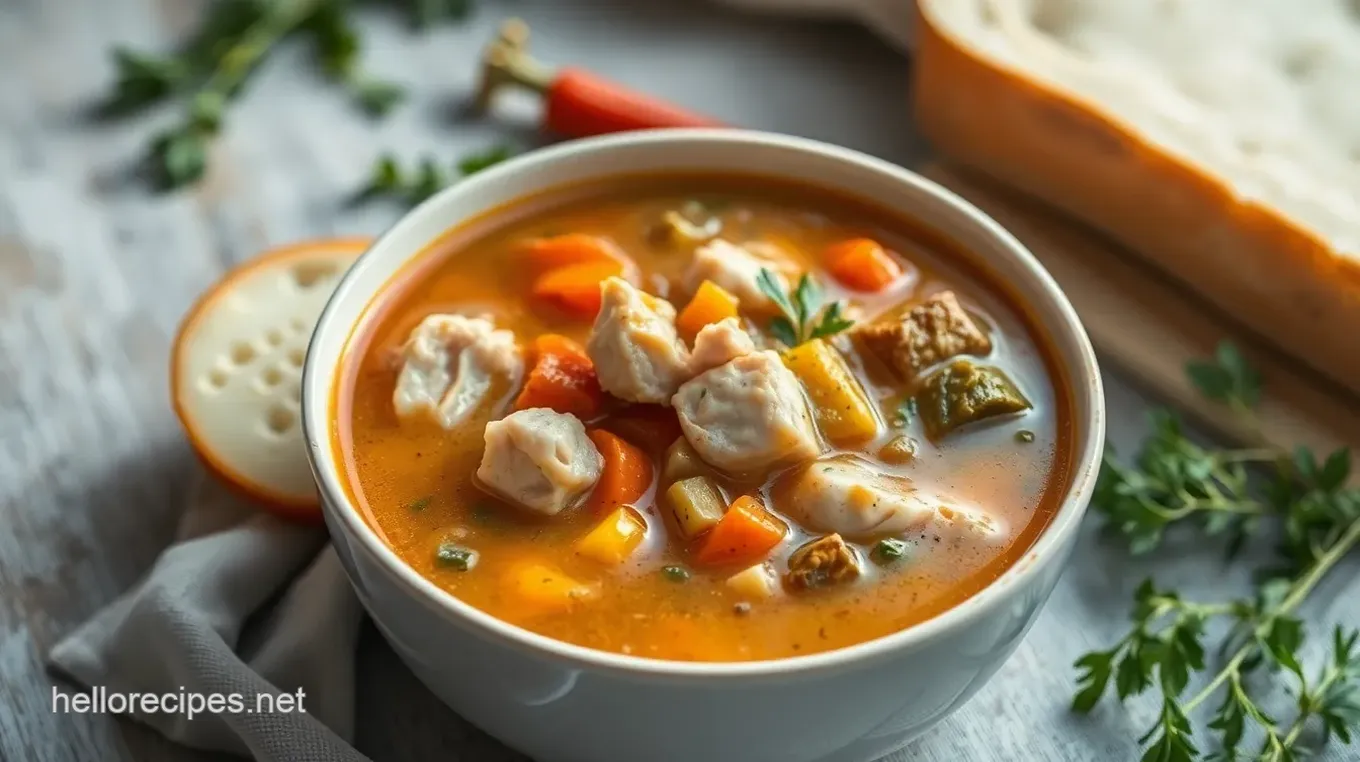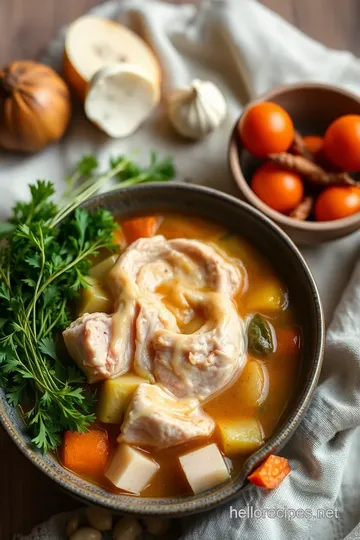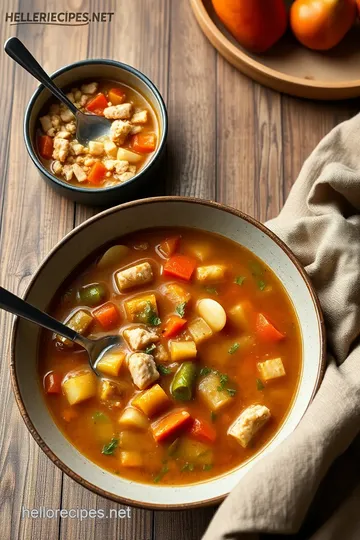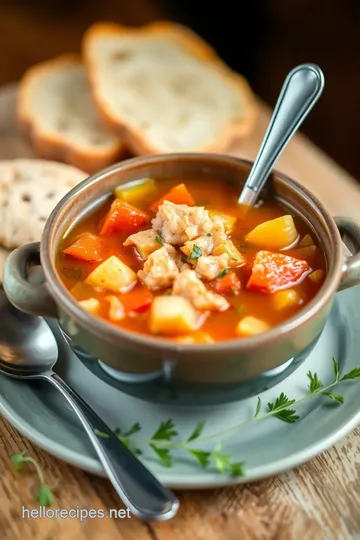My Grandmother's Simmered Turkey Soup with Savory Veggies
Craving comfort? This Simmered Turkey Soup with Savory Veggies is a warm embrace in a bowl. Perfect for using leftovers, it's easy, nutritious, and delicious!

- Simmered Turkey Soup with Savory Veggies: A Bowl of Comfort
- A Taste of History and Modern Comfort
- Why You’ll Love This Soup
- The Advantages of Turkey Soup
- Transition to Ingredients
- Essential Ingredients Guide
- Mastering the Art of Professional Cooking: Your Comfort Food Cheat Sheet
- Delicious Pro Tips & Secrets for Your Simmered Turkey Soup with Savory Veggies
- Perfect Presentation for Cozy Vibes
- Storage & Make-Ahead Strategies
- Creative Variations for Personalized Flavors
- Complete Nutrition Guide for Guilt-Free Indulgence
- Recipe Card
Simmered Turkey Soup with Savory Veggies: A Bowl of Comfort
Oh my gosh, have you ever just needed a big hug in a bowl? that’s exactly what i felt after the whirlwind of the holidays.
One moment, we’ve got a feast laid out, and the next, we’re staring at a mountain of leftover turkey and wondering, “what on earth do i do with this?” enter simmered turkey soup with savory veggies .
This cozy turkey soup recipe became a go-to in my kitchen, especially during those chilly autumn days when nothing hits the spot quite like a steaming bowl of soup.
A Taste of History and Modern Comfort
Let’s dive a little into the roots of turkey soup. historically, folks have always found ways to stretch a meal, especially during winter months.
Turkey soup, in particular, has transformed from simple broth-based meals to a beloved dish in many households. today, this soup is popular not just for its heartiness but for its fantastic flavor packed with fresh veggies.
When you’re looking at your clock, a total time of about 50 minutes —including prep—makes this recipe easy-peasy. plus, it delivers 4-6 servings , so it’s perfect for families or meal prep.
And let’s be real, soup is one of the best cheap meal ideas out there.
Why You’ll Love This Soup
Now, let’s talk about the good stuff: the health benefits! this homemade turkey soup is loaded with nutrition. the veggies provide plenty of vitamins, and hey, it’s a great excuse to sneak in that zucchini you bought with good intentions.
Plus, it’s a low-sodium soup option since you can control the salt level. nutrient-rich soup ? yes, please!
You’ll find this soup is perfect for special occasions like cozy family dinners or casual gatherings when you hit the chilly season.
Whether you're serving it on a casual tuesday or a festive friday, it fits right in. it's also a hit for freezer-friendly soups ; make a double batch, store some for a rainy day, and voilà—easy dinners for the next few weeks!
The Advantages of Turkey Soup
One of the notable features of this vegetable-rich soup recipe is its versatility. sticking to classic turkey and veggie flavors is fantastic, but you can spice it up if you’re feeling adventurous.
Toss in some red pepper flakes for a kick or fresh herbs for that gourmet touch. sure, a creamy version could be fun too, but i love the simplicity of this light and healthy soup for a weekday meal.
And if you’ve got kids, this is definitely a family-friendly recipe. it’s an easy way to get them to eat their veggies without any fuss—trust me, the appeal of a cozy bowl does wonders.
Transition to Ingredients
So, how do we whip up this scrumptious bowl of comfort? let’s get you into the kitchen! below, you’ll find the ingredient list you need to create your very own savory simmered turkey soup with fresh vegetables .
You’ll have your cozy soup recipe ready in no time!
Are you ready? Let’s dive into those ingredients!

Essential Ingredients Guide
When whipping up a savory simmered turkey soup with fresh vegetables , knowing your ingredients is half the battle. let’s dive into what you'll want to have on hand and how to choose the best stuff.
Premium Core Components
First things first, let’s talk measurements. for this turkey soup recipe, you’ll need 2 tablespoons of olive oil (30 ml) , 1 medium onion, chopped (about 1 cup / 150 g) , and some other fresh veggie friends.
Trust me, getting your measurements right makes a world of difference. for metric love , just follow those handy conversions.
Next, you want to keep an eye on quality indicators when shopping. look for an olive oil that’s labeled as extra virgin for that rich flavor.
When it comes to vegetables, check for firmness and vibrant colors; dull veggies just don’t cut it!
Storage is key, too. fresh herbs like parsley can hang tight in the fridge for about a week, but your turkey broth? make sure it’s tightly sealed; it stays good for about a week in the fridge but can last months in the freezer.
Signature Seasoning Blend
Alright, now let’s spice things up! a killer soup needs a killer seasoning blend. for savory flavor, you’ll throw in 1 teaspoon of dried thyme (5 g) and 1 teaspoon of dried rosemary (5 g) .
Don’t skimp here—herbs are your best friends.
If you like going regional, consider adding some smoked paprika for a Southern twist or maybe a pinch of chili for those cozy soup recipes that warm you right up.
Smart Substitutions
Cooking with leftover turkey ? great idea! but what if you’re out of some ingredients? no worries! try swapping in rotisserie chicken if you’ve run out, or even chickpeas for a plant-based option.
And if you’re watching your sodium (hey, so am I sometimes), you can go for low-sodium broth options . I always keep some on hand for quick soups on busy days.
Kitchen Equipment Essentials
You don’t need a fancy kitchen to whip up this beauty, but a few tools will help. a large stockpot or dutch oven is where all the action happens.
If you’re in a pinch, a deep skillet can work too.
A wooden spoon is perfect for stirring without scratching your pot, and a good chef's knife will make chopping a breeze.
Just remember to have a cutting board ready; no one wants a messes on the counter!
Now that we’ve laid all that groundwork, let’s talk about what really matters—those delicious steps to get you to that first warm, cozy bite of turkey soup with fresh veggies.
You know, the kind that wraps you in a hug on chilly days, perfect for those autumn soup recipes we all crave.
Ready? Let’s get cooking!
Mastering the Art of Professional Cooking: Your Comfort Food Cheat Sheet
Cooking might seem like child’s play, but there’s a whole world of professional techniques that can elevate your kitchen game—especially when it comes to crafting comforting staples like simmered turkey soup with savory veggies .
Let me walk you through the essential preparation steps, the step-by-step process, expert techniques, and some success strategies so you can whip up this cozy soup in no time.
Gear Up: Essential Preparation Steps
First things first, let’s talk mise en place . this french term may sound fancy, but it just means having everything ready before you start cooking.
Chop your veggies: 1 cup of onions, a couple of carrots, and some celery. keep them in bowls. trust me, this saves you a lot of stress!
Now, timing is key! Make sure to gather all your ingredients ahead of time. Picture it: You’re simmering turkey soup, and then you realize you’re out of broth. Oof, right? Plan accordingly.
Organization strategies matter, too. keep your cutting board clean and your tools nearby. it’ll keep things tidy and efficient. and let’s not forget about safety; always be careful with sharp knives and hot surfaces.
Trust me; no one wants a trip to the er on a cozy soup-making day!
Step-by-Step Process: Time to Get Cooking!
Here’s how we make a bowl of pure comfort.
-
Sauté the veggies : heat up 2 tablespoons of olive oil in a large pot over medium heat. toss in 1 cup of chopped onions.
Cook them until they’re translucent—about 3 minutes . pro tip: stir often.
-
Next up : add 2 cloves of minced garlic, along with those carrots and celery. cook them all together for about 5- 7 minutes until tender.
It already smells awesome, right?
-
Make It Colorful : Stir in 1 cup of diced zucchini and 1 cup of green beans. Let them sauté for 3 minutes.
-
In goes the broth : add 4 cups of low-sodium chicken or turkey broth and 2 cups of shredded turkey .
Toss in 1 teaspoon of dried thyme and rosemary. season with salt and pepper. don’t be shy; you want this flavor to pop!
-
The waiting game : bring your soup to a boil, then let it simmer uncovered for 20- 25 minutes .
Keep an eye on it. you want those veggies to be tender but not mushy.
-
Final Touches : Taste and adjust seasoning. If it’s feeling bland, give it a pinch of salt or a sprinkle of fresh herbs.
-
Serve It Up : Ladle your soup into bowls. If you want to be fancy, garnish with fresh parsley. Everyone loves a little green on top!
Expert Techniques: Little Tricks from the Pros
Want to know what the pros do? It’s all about quality. Always check your veggies for freshness. Brown spots? Nope, don’t want those!
Need to troubleshoot? If your soup feels a bit watery, mix a tablespoon of cornstarch with water and stir it in. That’ll thicken things right up!
And, don’t forget about temperature control! Keep your soup at a gentle simmer after bringing it to a boil. Too much heat will ruin those delicate flavors you worked so hard for.
Success Strategies: Avoid Rookie Mistakes
Here’s what I’ve learned over time. The biggest mistake? Not tasting along the way. Seriously! A tiny adjustment can transform your homemade turkey soup .
Consider making it ahead of time. It’s a classic make-ahead option that actually gets better overnight. And don’t forget, this recipe is perfect for those leftover turkey ideas after the holidays!
If you’re prepping for the week, you can store it in the freezer. It’s one of those freezer-friendly soups that saves lives when you're too busy for a full-cooked meal.
So there you have it! with these tips in your back pocket, you’re ready to make the most mouthwatering simmered turkey soup with savory veggies .
Look into into your kitchen and give it a try—comfort food awaits!
Next up, we’ll explore Additional Information to round out your soup game! Stay tuned for more great tips.

Delicious Pro Tips & Secrets for Your Simmered Turkey Soup with Savory Veggies
I gotta tell you, when it comes to making simmered turkey soup with savory veggies , it’s all about those little tips that really elevate the dish.
I’ve learned a few tricks that’ll save you time and just take your soup from “meh” to “wow.”
First off, prep ahead . if you chop your veggies the night before, your 10-minute prep time becomes a breeze. i like to use a mix of carrots, celery, and that hearty zucchini.
Seriously, zucchini in soup is the move . don’t forget to sauté them well—especially the onion and garlic to bring out that sweet flavor.
It’s like giving your soup a little hug before it starts simmering!
Flavor enhancement? no brainer—go heavy on the herbs! fresh parsley or some dry thyme adds a killer aromatic kick. a dash of lemon juice right before serving can really brighten things up too.
Oh, and remember, if you wanna impress, toss in a few fresh herbs just before serving—that’s your plating secret right there.
Perfect Presentation for Cozy Vibes
When it comes to plating , think simple and satisfying. use a big soup bowl that makes your hearty soup feel like a warm embrace.
Skim off any fat that rises to the top to keep it looking fresh and inviting—nobody wants a greasy-looking soup.
Garnish is where you can shine! just throw some fresh parsley on top or a sprinkle of black pepper for contrast.
And the color combo? think bright greens from the veggies, sweet orange carrots—it's a fiesta for your eyes! serve this up with crusty bread, and you’ve got a spread that looks straight out of a foodie magazine!
Storage & Make-Ahead Strategies
So you whipped up simmered turkey soup and got leftovers? you’re in luck! this soup is not just delicious; it’s also perfect for make-ahead meal prep .
Store in an airtight container and it’ll keep well in the fridge for about three to four days.
If you’re keen on extending its life, this is absolutely a freezer-friendly soup . just let it cool down completely before you store it in a freezer bag.
It should last about three months in the freezer. pro tip: label your bag with the date, and you won't play that "what's in the freezer?" guessing game.
When you’re ready to eat, just reheat it slowly on the stove or microwave. add a splash of broth or water—the soup can thicken a bit after chilling, and we want it creamy, not chunky! trust me, it tastes even better the next day as the flavors marry together.
Creative Variations for Personalized Flavors
Now, let’s talk creative variations . have some fun with this soup! try adding seasonal veggies like squash in the fall, or throw in some frozen peas for that pop of color and sweetness.
If you’re down to spice things up, a hint of red pepper flakes makes it lively!
And hey, if you’re working with a crowd, think dietary modifications—swap turkey for beans for a vegetarian option . or, try using plant-based broth options if you want to keep it light and healthy.
I swear, this soup has something for everyone.
Complete Nutrition Guide for Guilt-Free Indulgence
Last but not least, let's not forget about nutrition . this soup packs a punch— 280 calories per serving, filled with protein thanks to that turkey, and tons of nutrients from all the veggies.
You’re getting your veggies in without even trying! honestly, it’s one of those healthy turkey soup recipes that doesn't sacrifice on flavor, making it a comfort food dream .
So, the next time you're staring at leftover turkey, think about this comforting, nutrient-rich soup . create a delicious dish that’s not just good for the belly but also for the soul.
Gather your ingredients, hold onto these pro tips, and let’s make a bowl of that savory goodness! look into in and enjoy—you deserve it!

My Grandmother's Simmered Turkey Soup with Savory Veggies Card

⚖️ Ingredients:
- 2 tablespoons olive oil
- 1 medium onion, chopped
- 2 cloves garlic, minced
- 2 medium carrots, sliced
- 2 celery stalks, sliced
- 1 medium zucchini, diced
- 1 cup green beans, trimmed and cut into 1-inch pieces
- 4 cups low-sodium chicken or turkey broth
- 2 cups cooked turkey, shredded or diced
- 1 teaspoon dried thyme
- 1 teaspoon dried rosemary
- Salt and pepper to taste
- 2 tablespoons fresh parsley, chopped (optional for garnish)
🥄 Instructions:
- Step 1: Heat olive oil in the pot over medium heat.
- Step 2: Add chopped onion and sauté until translucent (about 3 minutes).
- Step 3: Stir in garlic, carrots, and celery; cook until tender (about 5-7 minutes).
- Step 4: Incorporate zucchini and green beans; sauté for an additional 3 minutes.
- Step 5: Pour in the broth, and add shredded turkey.
- Step 6: Stir in thyme and rosemary; season with salt and pepper.
- Step 7: Increase heat to bring the soup to a boil.
- Step 8: Reduce heat and let it simmer uncovered for 20-25 minutes, until vegetables are tender.
- Step 9: Taste soup and adjust seasoning if needed.
- Step 10: Ladle soup into bowls, garnish with fresh parsley if desired, and enjoy!
Previous Recipe: Ultimate Hearty Slow Cooked Chicken Pot Pie Soup for Cozy Days
Next Recipe: Easy Roasted Tomato Soup with Grilled Cheese: My Comforting Classic
